A vibrant city has both affordable housing and access to safe transportation, the two go hand in hand — or at least they should. But in the face of Portland’s housing crisis, the city is pursuing a Regulatory Relief Project which “aims to increase housing production” through “temporary waivers and permanent changes” to certain building requirements — including bike parking standards. The Portland Planning Commission will hold a hearing about the proposed changes next Tuesday and is soliciting public comment.
Reports and bulleted lists can be mind-numbing, but this is the kind of insider baseball that determines how easily you will be able to park your bike. Put simply: code changes affect your life.
Here’s what you need to know…
Background
The Regulatory Relief Project began with last winter’s Bureau of Development Services survey of developers and others involved in the permitting process. The purpose was to learn what were the obstacles to increased housing production. Readers might remember that survey respondents viewed bike parking as a key cause of delayed housing production, and that a consultant working for the city estimated that bike parking in particular can add 3 to 6% to a project cost.
The survey results, particularly the narrative responses, were informative. Keep in mind that for-profit developers did not make up the majority of those surveyed, even the group of city staff outnumbered them. Other respondents included: applicants for construction permits; non-profit organizations developing new housing; businesses and professionals involved in housing development (like lawyers and architects); and city employees from the seven bureaus who review permits.
Last month, the Bureau of Planning and Sustainability released a draft set of 16 zoning code amendments in response to what was learned from the survey. The amendments are intended to provide regulatory relief and speed up housing production. They included changes to “requirements for bike parking, ground floor active use and height, nonconforming upgrades, bird-safe glazing, eco-roofs, façade articulation, neighborhood contact, and onsite loading spaces.”
Proposed Changes to Bike Parking
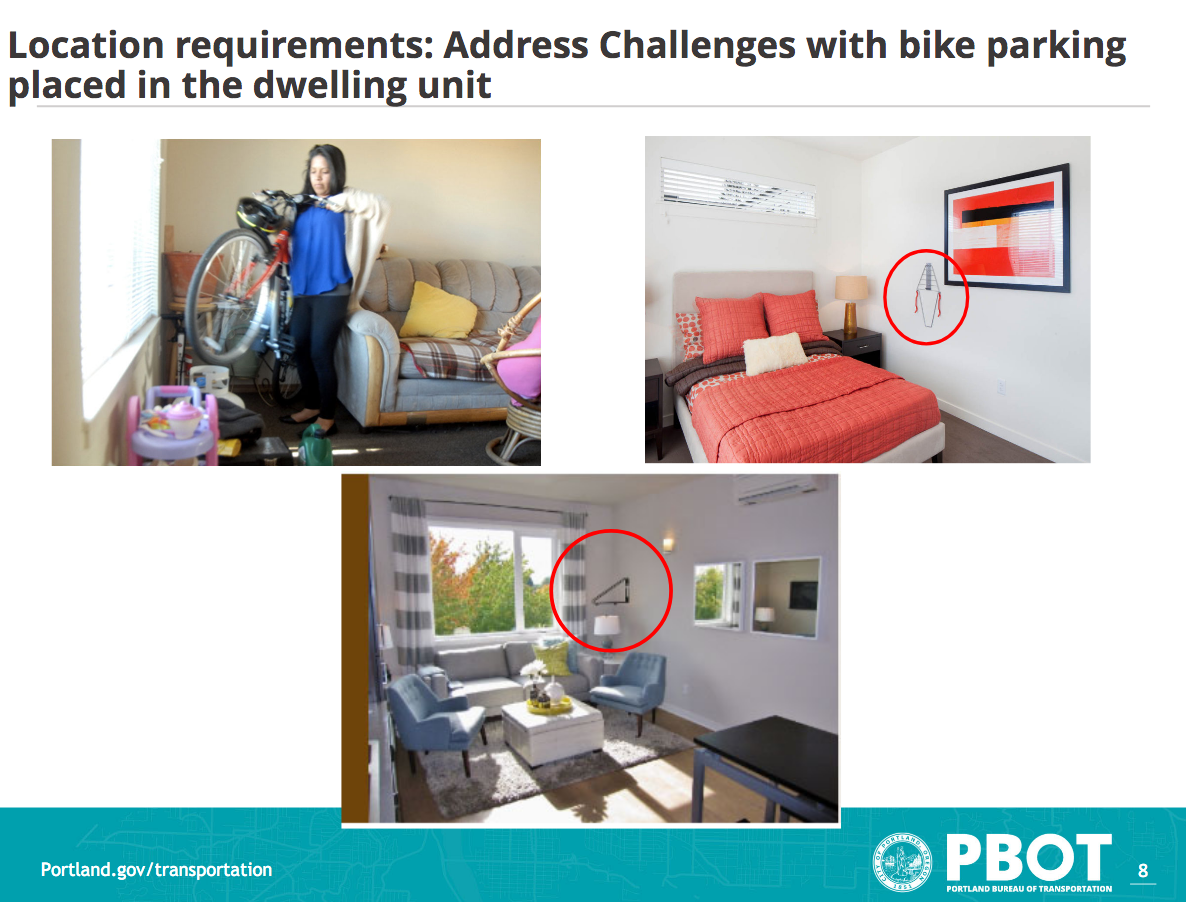
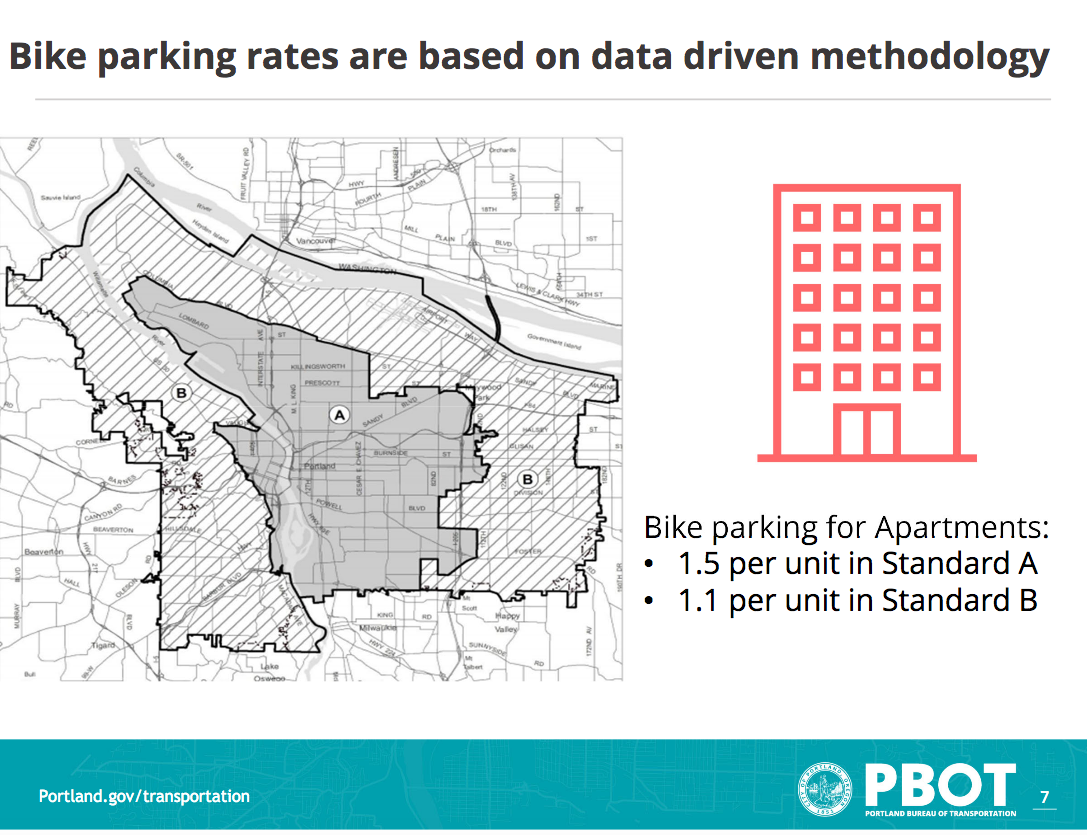
The specific changes proposed to the bike parking requirements are:
- Temporarily reduce the ratio of required bicycle parking from 1.5 to 1.0 spaces per dwelling unit in the inner pattern area and from 1.1 to 0.7 spaces in the outer pattern area.
- Temporarily suspend the requirement for large (i.e. cargo) bicycle parking spaces.
- Permanently eliminate the requirement for an alcove and proximity to the front door for bikes within dwelling units.
The Portland Bureau of Transportation made a presentation to the Bicycle Advisory Committee in August, and their slide deck explains the issues bulleted above.
But even with a helpful slide deck, land use and development are intricate subjects. Understanding the implications of the proposed changes is difficult for a lay person, partly because anyone with the technical expertise to really understand the issues probably also has a financial interest in a certain outcome. So figuring out who to listen to can be difficult.
My approach has been to do a lot of listening, to everybody, and to keep in mind the interests of the person doing the talking. Here are some of the people and groups I checked in with to balance out the survey findings and consultant reports.
Chris Smith
I reached out to Chris Smith, a long-time Portland transportation activist, who as a Planning and Sustainability Commissioner several years ago was deeply involved in designing Portland’s current bike parking code. Given his role in crafting the current code, I was surprised by how measured and moderate his response to the Relief Project was. He wrote:
There’s a very real policy trade off between building parking for the 15-25% bike mode share we want in 2030+ versus increasing housing cost now (and allegedly making some projects not pencil out now). I think adjusting the ratios temporarily is a valid thing to do in response.
Temporarily removing the cargo bike space (10′ x 4′) requirement is probably also reasonable until/unless we can demonstrate that folks who buy big front-loaders often live in multi-family housing. Most long-tail cargo bikes can probably squeeze onto a standard staple rack.
One of his specific concerns was the removal of the in-unit bike alcove:
The one that troubles me the most is the removal of the ‘alcove’ standard for in-unit bike parking. We know that before we introduced that standard a lot of in-unit parking was not in fact usable. [Ed: see the PBOT slide deck for photos of oddly-placed, unuseable bike hooks.] But I also concede that the alcove standard has proven challenging, particularly the way BDS has enforced it. I’d really like us to keep working on a better in-unit standard.
But mainly Smith viewed the project as an emergency package, one put together very quickly, and he is advocating for further study after the package is adopted, “I think there’s there’s a lot we could do if we had time to do a really good policy process …”
BikeLoud PDX
BikeLoud Chair Nic Cota told BikePortland that the organization is working with Portland Neighbors Welcome, an affordable housing group, as well as with Chris Smith, on a unified letter to the Planning Commission which recognizes that affordable housing and affordable and safe transportation “are two sides of the same coin.” The draft is currently being reviewed by all parties. Cota emailed that,
Overall our groups are asking that the Planning Commission and City Council assign a work group to review bike parking usage to understand how Portlanders use available bike storage, and look at how the code can be adjusted in the near future. We also want the commission to acknowledge how the code can best provide for the anticipated growth in e-bike ownership, especially as the city looks to roll out Portland Clean Energy Fund initiatives that gears to providing e-bikes to thousands of Portlanders in the next 5 years.
The Street Trust
The Street Trust (TST) wrote a letter and detailed technical memo to Commissioner Rubio, with a copy to PBOT, BPS, and the Planning Commission. This is the most prescriptive of the three approaches, and goes as far as to make dimensional, size recommendations to the code. TST Board Director Victor Duong signed the letter. Duong is a project manager at an architecture firm which might be why TST felt comfortable getting so deep into the design weeds.
The group also specifically brought up BIPOC inclusion at several points: “Finally, we ask all future regulations to be more BIPOC-equity focused because we can’t achieve 25% bike trips by 2030 if we are not including 25% of our population’s needs in our system design and execution,” and
Temporarily remove Design Review requirements for BIPOC owners/developers and consider a permanent removal until the city meets min diversity requirements for review board members. DR is a financial burden for small BIPOC owned projects.
And Duong ended the letter with some punch,
Commissioner Rubio, the time for bold action is now. We have a unique opportunity to redefine Portland as a city that leads with compassion, innovation, and inclusivity. Our plans, policies, and codes must be pro-human, not pro-bike or pro-housing. We are crafting a city for people, not just buildings and bikes.
Conclusion
Assuming that the Planning Commission approves the proposed code changes, the next step in the code change process will be a City Council hearing and vote to approve the code. According to the project timeline, the Council hearing will be in December.
The Regulatory Relief Project has an online tool for submitting comments to the Planning Commission, and so far 92 people have commented. A glance through the comments shows that there is much more on the table than just bike parking. As I eyeball the list, it looks like window glazing for protecting birds is a much hotter topic than bicycles.
The deadline for comments to be considered before Tuesday’s hearing is 5:00 PM Monday afternoon.


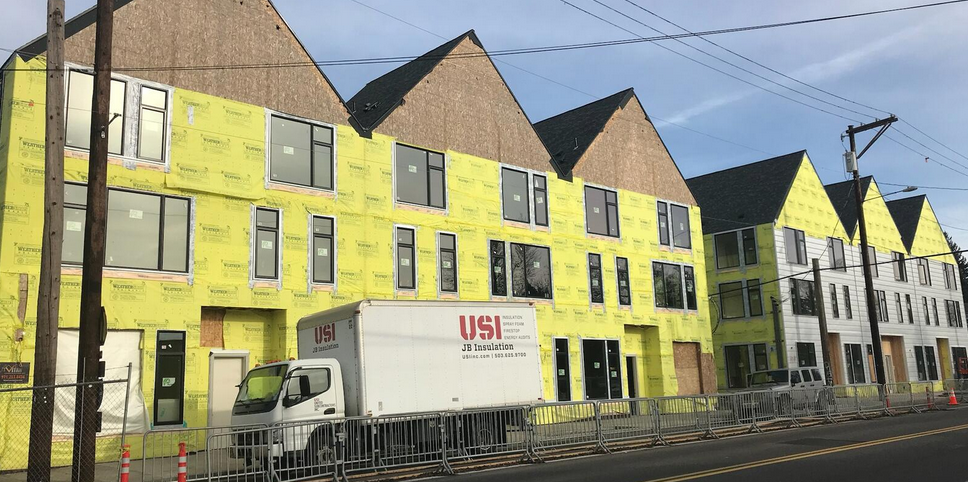
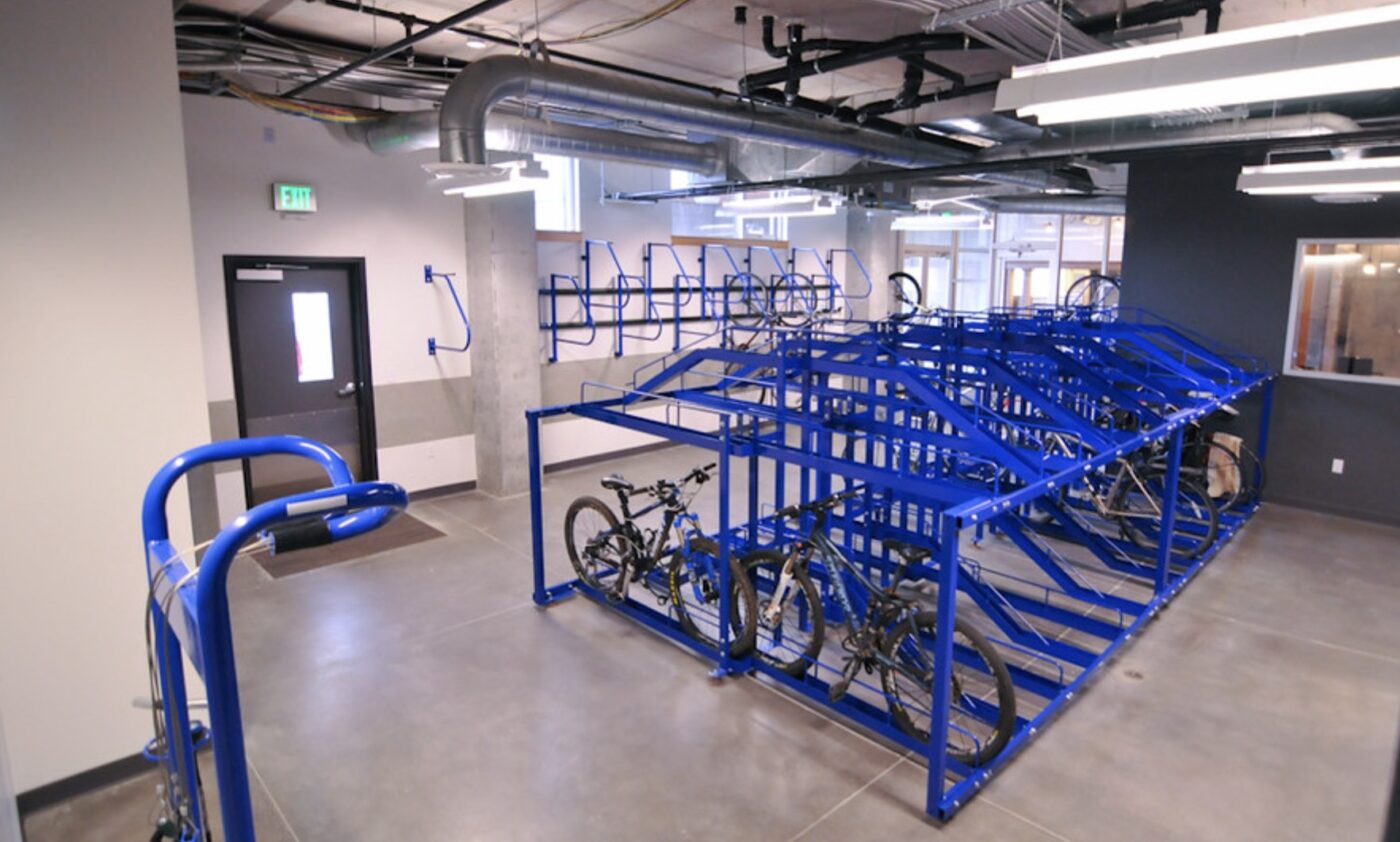
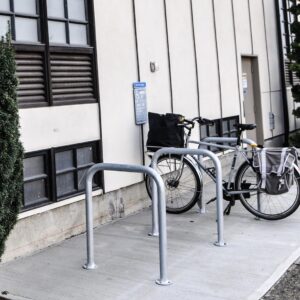
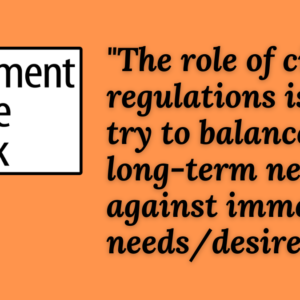
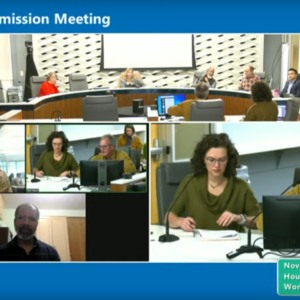

Thanks for reading.
BikePortland has served this community with independent community journalism since 2005. We rely on subscriptions from readers like you to survive. Your financial support is vital in keeping this valuable resource alive and well.
Please subscribe today to strengthen and expand our work.
If concessions are going to be made on space requirements I’d like to see a requirement for an ADA accessable corridor between bike rooms and the street so people don’t have to navigate multiple heavy fire doors pushing a bike. I’d also add a specific requirement for access control devices (fob readers, etc.) to be in close proximity to door latches or opener buttons.
I’ve just moved between two buildings on the fringes of downtown that are both less than a decade old and presumably met bike parking requirements when built. It’s pretty clear that nobody responsible for design and installation of facilities in either building was a cyclist because although they met regulatory requirements some details were painfully implemented.
I’m pretty sure old building didn’t give cyclists who didn’t pay for car parking a garage door opener forcing them into the elevators requiring a route through non-ADA doors that are tough to navigate with a bike. All parking was cage in garage style with about 25%-30% occupancy plus a few surfboards. If you preferred one of the locked cages access was via valet (who was busy parking cars but provided a consistent presence) which caused delays coming and going. The work stand was in a spot that had so little lighting it was difficult to use. There was no in-unit storage hooks. The bike cages only had vertical racks for conventional bikes and creativity would be required for people with heavy bikes, cargo bikes, or trailers but there was enough unused space to make something work.
New building has a storage alcove just inside the apartment entrance which will be a decent place for a freestanding coat rack. There’s a few cages in the garage using otherwise dead space to meet capacity requirements that seem to be currently in use for building maintenance storage. There’s a a well lit bike room below adjacent to the elevator core in a location that might not have much other use. Unfortunately this bike room doesn’t have at grade access to the street also requiring elevator use. The bike room door has heavily sprung door closer and a key fob reader on the hinge side that makes it difficult to navigate. There’s a decent mixture of vertical racks, horizontal racks, and staples to accommodate all types of bikes and a few charging outlets. There’s a useful mechanic’s stand in a well lit are with essential tools. New building with $250 a month assigned parking spaces also has a ridiculous but likely unenforced prohibition on “car storage” requiring vehicle use every three days.
P:NW advocates for Randian deregulation with the intent to increase developer profits. Many of their members naively believe that housing speculators will over-build and slow rapid appreciation at the expense of their own profits. I guess supply is no longer regulated by demand when it comes to developer profits.
Housing is a human right and market-based housing is fundamentally incompatible with this right.
What? You don’t think the problem that has been growing for decades is mostly caused by this bike parking regulation that was introduced recently?
if we really want to encourage free market housing production we should stop forcing developers to build sidewalks and bike lanes. sidewalk minimums are killing housing! developer fees (sdcs) and the expensive bikelanes they allow reduce the number of housing a developer can build so let’s abolish them.
more seriously, the willingness of all of semi-professional transportation advocates/researchers to throw bike parking regulations under the excavator for a tiny increase in developer margin is really something.
It’s for a decrease in rents, which is what happens when you reduce the cost of building housing and allow more units to be built.
Not really. You get the same price but more cash in the developer’s pocket. Maybe over the long term there’s some theoretical marginal decrease, but small decreases in developer cost will not result in cheaper units.
The real constraints at the moment are labor and materials, and maybe also permitting delays. These will not be addressed by making building less sustainable.
It’s a trap.
I’m more of the opinion that requiring developers to build new traffic signals was even more of a burden, but what do I know? Getting hit with a $200,000 new signalized intersection as part of a $2 million housing project hurts.
Study after study has shown that when you actually build enough housing, rents go down or stay flat rather than growing. It’s all about the supply and demand. “Developer profits” in the sense that you’re implying (i.e., excessive developer profits) are only possible if housing production is constrained through zoning and regulations, allowing the few apartment buildings that are built the ability to charge excessive rents. If more buildings are constructed, there’s more competition and choice for people looking for housing, and rents have to be moderated (and with them the profits).
How many additional units do you think we’ll get over the next 5 years by relaxing bike parking standards? How much do you think rents will fall as a result? I’d put my money on “approximately zero”.
Is that worth baking in an increment of less accessible biking for the next 100 years?
I’d say comment of the week but it’s probably too short. It really is straight forward, they’re trying to make a change that will make housing worse for the lifetime of the buildings (I assume that’s the 100 years you mean) for a difference in cost that will 100% go into the pockets of the developers with no change in rent or house prices.
Is it legal to remove legal requirements (like design review) only for people of a certain racial group?
The short answer is “yes”, but it’s a huge legal gray area. All cities try to actively promote MWDBE (minority, women, and disabled business enterprises) contracting for city services and will often reduce certain regulations related to such enterprises, including developers, towards meeting those goals, which has so far been largely tolerated and even encouraged by the courts. It’s too easy to think of “land development” as being entirely market-driven, but it is often subsidized in many communities with tax abatement, lower regulation requirements, and even outright financial subsidies, for example providing more high-quality housing in East Portland or more low-income housing in the Pearl. The idea is cities want a balance of incomes in any part of a city and generally market-based solutions don’t actually do that, hence the need for regulation and subsidies, as well as affirmative-action type discrimination of which developers get public support.
While I definitely don’t know much about it, I just remember the Oregon Cares Fund settling pretty quickly when the legality of their program was questioned and don’t entirely understand why this wouldn’t face similar equal protection questions.
In my opinion, I think it has more to do with how much money and impact such policies have. As long as MWDBE or BIPOC developers have only minimal impact on the overall market (in many jurisdictions it’s less than 2% of all developments, the other 98% being white male dominated corporations and builders), no one will really care, least of all the courts – it’s all window-dressing without any real social impact.
Unlike the Oregon Cares Fund, MWDBE policies includes a much wider class of recipients, including white women and white disabled men and women. However, I agree this is still an often untested legal area in many jurisdictions.
Haven’t you heard? Fighting racism with even more and continuing racism is the best way to go to fix societies ills.
/s
Painting racism with a different “color” isn’t going to work in the long run either.
This is a little bit of an odd statement when majority of the members of the Design Commission are people of color, which has been the case for years now.
The Street Trust hit the escape pod from USS Reality years ago.
Applying different design standards to different people based on their skin color is a great way to lose a lot of money defending and losing a lawsuit.
Chris Smith writes:
The housing crunch is a short-term problem (remember our shortage of office space a few years ago?) The buildings we build today will be with us for the next 100 years, so we are trading a wishful short-term benefit (cheaper housing) for a certain long-term problem (lack of bike parking for people who rent).
I very often agree with Chris, but not this time.
Unfortunately a lot of the concrete and asphalt we have won’t last 100 years, especially the newer crap – it will need replacing well within 50 years, some a lot sooner than that.
What will bikes be like in 2123?
“What will bikes be like in 2123?”
They’ll be as different from today’s bikes as ours are from those in 1923.
Which is to say, essentially the same from a bike parking viewpoint.
Should we also bring back car parking minimums? One could make the exact same argument.
Only if you believe providing parking for cars is equally beneficial to providing it for bikes.
Reducing private car use is a longstanding policy goal, as is increasing bike use (notice the difference?) That suggests different approaches.
Besides, I think we’re very likely to need a lot less private parking in the medium-term future.
Unless they are specifically dedicated to creating affordable housing (as defined by income of all residents), developers’ goals are always about maximizing their profit. Does requiring bicycle parking inhibit them from reaching that goal? Why yes, it does. So do most aspects of any state or local building code, things that ensure fewer people die from fires or earthquakes. Developers seldom declare that they would build more housing if the housing didn’t have to meet code for fire safety, because we all agree that having people die in a fire is bad. Unfortunately, we do not seem to agree that having people die from motor vehicles (not just accidents, but all the health effects and climate catastrophe to which these vehicles contribute massively) is bad. Therefore, Commissioner Rubio and others can be made to believe that “temporarily” suspending these requirements is beneficial. And again, it’s not like the trade-off is even AFFORDABLE HOUSING for people who currently cannot access stable housing. It’s about the amount of profit for developers. If we want to maximize construction of affordable housing, we could just ban all other construction until we have enough affordable residential stock for everyone. No more luxury hotels! No more adding an extra bathroom to your single family home! Just affordable housing! Of course we won’t do that. Because luxury hotels and extra bathrooms are … more worthy than bike parking???
Guess they haven’t paid much attention to bike trends, both locally and nationwide.
I think removing the alcove requirement is a good idea. I lived in an apartment with an alcove for 2.5 years and I used it to store my bike. It was nice to have it but the alcove requirement made my apartment’s floor plan really weird. It had a long narrow hallway with a bike alcove in it and two 90 degree turns. The narrow alcove was great for storing one bike, but it made it very difficult to fit a second bike (and this was in a two bedroom)
I’d much rather just have a bike hook in the living room than a legally mandated bike hook alcove. Apartments are pretty small these days, I say just give the space back to the living room
What about a caveat that says you don’t get to skip any of the current bike parking rules if you build even a single car parking spot.
The idea that bike parking makes buildings cost prohibitive while building expensive, land intensive, wasteful, climate ruining car parking infrastructure doesn’t hold water in my mind.
Lisa didn’t stress ths, but one thing: while many of the line items in this document do indeed say ‘temporarily suspend’ the rule for 5 years, it goes on to state that a great many of them will be permanently altered after that. So for now, we drop bike space ratios to .07; in 5 years maybe we go to 2.0, maybe we go to 0.0. Quien sabe?
Pretty insane that Portland, the closest thing we have to the Netherlands, is looking to become more like every other so-so city when it comes to biking.
Portland, Oregon. Let no half measure be left behind.
Hopefully the masses that rose up to defend Broadway bike facility will show up for this one too.
I think this is great news, though it doesn’t go as far as I would like. While I personally would want to live somewhere with secure bike parking, I don’t think it makes sense to mandate any bike parking, just like I don’t think we should mandate car parking. Either way, it’s increasing the cost of housing for everyone by imposing on everyone a thing that only some people actually want or use.
That is the libertarian viewpoint.